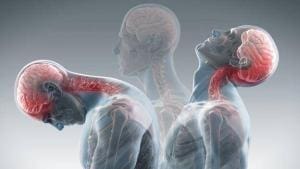
5 Things You Probably Don’t Know About Whiplash
While usually associated as a result of vehicular impact, whiplash can occur when you least expect it. From a rollercoaster ride to full contact sports like rugby – it could even happen when diving from a height and hitting your head before entering the water. Even pop icon Madonna was not spared when she claimed to have whiplash after falling during a performance in early-2015.
What causes whiplash?
Our Senior Physiotherapist Cheng Guang Hao explains that whiplash is caused from sudden jerking movements in your neck – your head thrown suddenly in any direction, before snapping back in the opposite direction. This overstretches and damages your neck’s muscles, ligaments, and joints, like when you roll and sprain your ankle.
Recognising whiplash symptoms
Swelling soon follows, which causes pain and muscles spasms, and limits your neck’s mobility. In more serious cases, this might affect your nerves, leaving your arm numb, tingling or in pain. You might also experience headaches, dizziness, and a dull ache even when not moving.
What should I do if I have whiplash?
Guang Hao stresses that the most important thing to do in such a scenario – in fact, any injury – is to stay calm. See the doctor for painkillers and anti-inflammatory medication, and avoid activity that might stress your neck for at least a week. Slowly test and increase movements in your neck as the pain begins to reduce. Following these steps, mild whiplash cases will usually be resolved in around two to four weeks.
What if the pain and immobility persist?
This could be because your neck’s stabilising muscles have been weakened from the whiplash. As a result, your neck may be poorly positioned or balanced, and have reduced muscle endurance and strength, which may lead to chronic neck pain.
Guang Hao compares it to how some people develop weak ankles after a bad sprain, due to weakened stabilising muscles around the ankle joint. To help resolve this, treatment by a medical professional like a physiotherapist is recommended to monitor and manage your recovery.
What are the different kinds of treatment?
To reduce muscle spasms, specific and affected muscles around your neck will be massaged. Joint stiffness will be addressed through joint mobilisation – making small and controlled movements to the affected joints. And neural mobilisation techniques may be used for nerve symptoms – identifying and moving the joints close to the affected nerves in your neck, to reduce your discomfort.
By targeting these problem areas, physiotherapy management reduces your risk of developing chronic neck pain in the future – to not only alleviate the pain, but to ensure that it does not return.
Experiencing neck pain? Click here to find out more about physiotherapy for neck pain relief and how Core Concepts can help.
Think you might have whiplash?
Did you also know that slow speed whiplash can occur as well? Schedule an appointment to speak with one of our therapists today. Simply contact us via one of the convenient methods below.
Related Articles
- Improving Your Cycling Performance In today’s fast paced world, it has become more difficult than ever for a working athlete to strike a balance…
- Bid Goodbye to Cycling Injuries Cycling is a wonderful sport - it helps you lose weight and keeps you fit. But did you know that…
- 3 Common Ski and Snowboarding Injuries and How to Avoid them Winter sports like skiing and snowboarding are enjoyed by many people worldwide, with many Singaporeans travelling overseas to enjoy winter…
- Quick Fixes for Common Cycling Pain and Injuries The physical and mental health benefits of cycling every day is undeniable – and of course, we can’t ignore that…
- HIIT Workouts: Check Your Form (Upper & Lower Body) High-Intensity Interval Training (HIIT) is an increasingly popular and effective way to get lean. HIIT Programmes strip away the…
